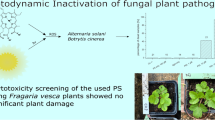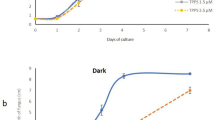Abstract
The ever growing world-population poses challenges concerning the need for more food free of pesticide residues. The most common means to control plant pathogens is through the application of pesticides, which raises concerns over safety for humans and the environment. Recently, Photodynamic Inactivation (PDI) of microorganisms using natural photosensitizers has shown itself to be a powerful tool to combat bacteria and fungi. This study investigates the efficacy of PDI against the Gram(+) bacterial plant pathogen Rhodococcus fascians and Gram(−) Xanthomonas axonopodis and Erwinia amylovora using two chlorin e6 derivatives as photosensitizers: anionic sodium magnesium chlorophyllin (Chl, approved as food additive E140) in combination with cell wall permeabilizing agents (Na2EDTA or Polyaspartic acid sodium salt (PA)) and B17-0024, a mixture of chlorin e6 derivatives with cationic moieties at physiological pH. Both photosensitizers show excellent efficacy against R. fascians, whereby B17-0024 is phototoxic at a one order of magnitude lower concentration than Chl (10 µM B17-0024: relative inactivation (r.i.) >7.5 × 106, 100 µM Chl: r.i. 2.2 × 106, illumination with 26.6 J cm−2, 395 nm). The photo-treatment of Gram(−) bacteria with Chl requires the obligatory use of cell wall permeabilizing agents like Na2EDTA (X. axonopodis) or PA (E. amylovora) to induce significant killing (more than 7 log units at 100 µM). On the other hand, B17-0024 proves to be a highly effective photosensitizer inducing bacterial inactivation at very low concentrations (10 µM for R. fascians and X. axonopodis, 100 µM for E. amylovora) without additives. In summary, PDI using both the natural photosensitizer Chl in combination with cell wall permeabilizing agents is effective and environmentally friendly. As an alternative, B17-0024 is highly photoactive against all model strains tested – even without cell wall permeabilizing agents. The photo-dynamic approach based on chlorin e6 derivatives should add to the growers’ toolbox as a preferred alternative for the control of phytopathogens.
Similar content being viewed by others
Abbreviations
- Chl:
-
Sodium magnesium chlorophyllin
- CFU:
-
Colony forming unit(s)
- DMSO:
-
Dimethyl sulfoxide
- DPBS:
-
Dulbecco’s phosphate buffered saline
- E. amylovora:
-
Erwinia amylovora
- PA:
-
Polyaspartic acid sodium salt
- PDI:
-
Photodynamic Inactivation
- PS:
-
Photosensitizer(s)
- P. syringae:
-
Pseudomonas syringae
- R. fascians:
-
Rhodococcus fascians
- r.i.:
-
Relative inactivation
- ROS:
-
Reactive oxygen species
- X. axonopodis:
-
Xanthomonas axonopodis
References
United Nations - Deparment of Economic and Social Affairs - Population Division, World Population Prospects: The 2017 Revision, Key Findings and Advance Tables, 2017, Working Paper No. ESA/P/WP/248.
M. Deggau, Die amtliche Flächenstatistik – Grundlage, Methode, Zukunft, https://www.destatis.de/GPStatistik/servlets/MCRFileNodeServlet/DEMonografie_derivate_00001577/FlaechenstatistikDL.pdf, (accessed 28.05.2019).
Umwelt Bundesamt, Umwelt und Landwirtschaft 2018, https://www.umweltbundesamt.de/sites/default/files/medien/421/publikationen/20180125_uba_fl_umwelt_und_landwirtschaft_bf_final.pdf, (accessed 20.03., 2018).
E. C. Oerke, Crop losses to pests, J. Agric. Sci., 2005, 144, 31–43.
K. B. Johnson, Fire blight of apple and pear, http://www.apsnet.org/edcenter/intropp/lessons/prokaryotes/pages/fireBlight.aspx, (accessed 30.01., 2018).
J. Mansfield, S. Genin, S. Magori, V. Citovsky, M. Sriariyanum, P. Ronald, M. A. X. Dow, V. Verdier, S. V. Beer, M. A. Machado, I. A. N. Toth, G. Salmond and G. D. Foster, Top 10 plant pathogenic bacteria in molecular plant pathology, Mol. Plant Pathol., 2012, 13, 614–629.
M. Longstroth, The 2000 fire blight epidemic in Southwest Michigan apple ochards, Compact Fruit Tree, 2001, 34, 16–19.
K. B. Johnson and V. Stockwell, Management of fire blight: A case study in microbial ecology, Annu. Rev. Phytopathol., 1998, 36, 227–248.
J. E. Loper, M. D. Henkels, R. G. Roberts, G. G. Grove, M. J. Willett and T. J. Smith, Evaluation of streptomycin, oxytetracycline, and copper resistance of, Erwinia amylovora isoloated from pear orchards in Washington State, Plant Dis., 1991, 287–290.
T. R. Gottwald and J. H. Graham, Citrus canker, https://www.apsnet.org/edcenter/disandpath/prokaryote/pdlessons/Pages/CitrusCanker.aspx, (accessed 28.05.2019).
M. L. Putnam and M. L. Miller, Rhodococcus fascians in Herbaceous Perennials, Plant Dis., 2007, 91, 1064–1076.
D. Vereecke, S. Burssens, C. Simón-Mateo, D. Inzé, M. Van Montagu, K. Goethals and M. Jaziri, The Rhodococcus fascians-plant interaction: morphological traits and biotechnological applications, Planta, 2000, 210, 241–251.
K. F. Baker, Bacterial fasciation disease of ornamental plants in California, Plant Disease Reporter, 1950, 34, 121–125.
S. O. Igbedioh, Effects of Agricultural Pesticides on Humans, Animals, and Higher Plants in Developing Countries, Arch. Environ. Health, 1991, 46, 218–224.
M. Wainwright, T. Maisch, S. Nonell, K. Plaetzer, A. Almeida, G. P. Tegos and M. R. Hamblin, Photoantimicrobials - are we afraid of the light?, Lancet Infect. Dis., 2016, 17, e49–e55.
T. Dai, Y.-Y. Huang and M. R. Hamblin, Photodynamic therapy for localized infections – state of the art, Photodiagn. Photodyn. Ther., 2009, 6, 170–188.
V. Jesus, D. Martins, T. Branco, N. Valério, M. Neves, M. A. F. Faustinob, L. Reisc, M. E. Barreal, P. Gallego and A. Almeida, An insight on photodynamic approach versus copper formulations in the control of Pseudomonas syringae pv. actinidiae in kiwi plants, Photochem. Photobiol. Sci., 2018, 17, 180–191.
A. Almeida, D. Martins, M. Faustino, M. Neves, L. Reis and E. Figueira, Photoinactivation of Pseudomonas syringae pv. actinidiae in kiwifruit plants by cationic porphyrins, Planta, 2018, 248, 409–421.
H. D. de Menezes, G. B. Rodrigues, P. Teixeira Sde, N. S. Massola Jr., L. Bachmann, M. Wainwright and G. U. Braga, In vitro Photodynamic Inactivation of plant-pathogenic fungi Colletotrichum acutatum and Colletotrichum gloeosporioides with Novel Phenothiazinium photosensitizers, Appl. Environ. Microbiol., 2014, 80, 1623–1632.
K. Kairyte, A. Kadys and Z. Luksiene, Antibacterial and antifungal activity of photoactivated ZnO nanoparticles in suspension, J. Photochem. Photobiol., B, 2013, 128, 78–84.
M. Glueck, B. Schamberger, P. Eckl and K. Plaetzer, New horizons in microbiological food safety: Photodynamic Decontamination based on a curcumin derivative, Photochem. Photobiol. Sci., 2017, 16, 1784–1791.
N. Tortik, A. Spaeth and K. Plaetzer, Photodynamic decontamination of foodstuff from Staphylococcus aureus based on novel formulations of curcumin, Photochem. Photobiol. Sci., 2014, 13, 1402–1409.
N. Tortik, P. Steinbacher, T. Maisch, A. Spaeth and K. Plaetzer, A comparative study on the antibacterial photodynamic efficiency of a curcumin derivative and a formulation on a porcine skin model, Photochem. Photobiol. Sci., 2016, 15, 187–195.
Z. Luksiene and E. Paskeviciute, Novel approach to the microbial decontamination of strawberries: chlorophyllinbased photosensitization, J. Appl. Microbiol., 2011, 110, 1274–1283.
I. Buchovec, V. Lukseviciute, A. Marsalka, I. Reklaitis and Z. Luksiene, Effective photosensitization-based inactivation of Gram (-) food pathogens and molds using the chlorophyllin-chitosan complex: towards photoactive edible coatings to preserve strawberries, Photochem. Photobiol. Sci., 2016, 15, 506–516.
F. F. Sperandio, Y.-Y. Huang and M. R. Hamblin, Antimicrobial Photodynamic Therapy to Kill Gram-negative Bacteria, Recent Pat. Anti-Infect. Drug Discovery, 2013, 8, 108–120.
A. Pieslinger, K. Plaetzer, C. B. Oberdanner, J. Berlanda, H. Mair, B. Krammer and T. Kiesslich, Characterization of a simple and homogeneous irradiation device based on light-emitting diodes: A possible low-cost supplement to conventional light sources for photodynamic treatment, Med. Laser Appl., 2006, 21, 277–283.
Instructions for Authors, https://aac.asm.org/sites/default/files/additional-assets/AAC-ITA.pdf, (accessed 29.04.2019, 2019).
R. D. Pearson, R. T. Steigbigel, H. T. Davis and S. W. Chapman, Method of reliable determination of minimal lethal antibiotic concentrations, Antimicrob. Agents Chemother., 1980, 18, 699–708.
P. C. Taylor, F. D. Schoenknecht, J. C. Sherris and E. C. Linner, Determination of minimum bactericidal concentrations of oxacillin for Staphylococcus aureus: influence and significance of technical factors, Antimicrob. Agents Chemother., 1983, 23, 142–150.
H. D. de Menezes, A. C. Pereira, G. T. P. Brancini, H. C. de Leão, N. S. Massola Júnior, L. Bachmann, M. Wainwright, J. K. Bastos and G. U. L. Braga, Furocoumarins and coumarins photoinactivate Colletotrichum acutatum and Aspergillus nidulans fungi under solar radiation, J. Photochem. Photobiol., B, 2014, 131, 74–83.
C. C. Vandresen, A. G. Gonçalves, D. R. B. Ducatti, F. S. Murakami, M. D. Noseda, M. E. R. Duarte and S. M. W. Barreira, In vitro Photodynamic Inactivation of conidia of the phytopathogenic fungus Colletotrichum graminicola with cationic porphyrins, Photochem. Photobiol. Sci., 2016, 15, 673–681.
E. Stes, I. Francis, I. Pertry, A. Dolzblasz, S. Depuydt and D. Vereecke, The leafy gall syndrome induced by Rhodococcus fascians, FEMS Microbiol. Lett., 2013, 342, 187–194.
J. H. Graham, T. R. Gottwald, J. Cubero and D. S. Achor, Xanthomonas axonopodis pv. citri: factors affecting successful eradication of citrus canker, Mol. Plant Pathol., 2004, 5, 15.
J. H. Graham and R. P. Leite, Lack of Control of Citrus Canker by Induced Systemic Resistance Compounds, Plant Dis., 2004, 88, 745–750.
F. Hippler, R. Boaretto, J. Antonio Quaggio and D. Mattos Jr., Copper in Citrus Production: required but avoided, Citrus Res. Technol., 2017, 38, 99–106.
S. George, M. R. Hamblin and A. Kishen, Uptake pathways of anionic and cationic photosensitizers into bacteria, Photochem. Photobiol. Sci., 2009, 8, 788–795.
H. L. Alakomi, A. Paananen, M. L. Suihko, I. M. Helander and M. Saarela, Weakening effect of cell permeabilizers on gram-negative bacteria causing biodeterioration, Appl. Environ. Microbiol., 2006, 72, 4695–4703.
M. Krüger, P. Richter, S. M. Strauch, A. Nasir, A. Burkovski, C. A. Antunes, T. Meißgeier, E. Schlücker, S. Schwab and M. Lebert, What an Escherichia coli Mutant Can Teach Us About the Antibacterial Effect of Chlorophyllin, Microorganisms, 2019, 7, 59.
J. L. Norelli, A. L. Jones and H. S. Aldwinckle, Fire Blight Management in the Twenty-first Century: Using New Technologies that Enhance Host Resistance in Apple, Plant Dis., 2003, 87, 756–765.
T. P. Knepper, Synthetic chelating agents and compounds exhibiting complexing properties in the aquatic environment, TrAC, Trends Anal. Chem., 2003, 22, 708–724.
B. Nowack, Chelating agents–overview and historical perspective, in, Complexing agents between science, industry, authorities and users, Monte Verità, Ascona, Switzerland, 2007.
J. Mosinger, M. Janošková, K. Lang and P. Kubát, Light-induced aggregation of cationic porphyrins, J. Photochem. Photobiol., A, 2006, 181, 283–289.
A. Minnock, D. I. Vernon, J. Schofield, J. Griffiths, J. Howard Parish and S. B. Brown, Photoinactivation of bacteria. Use of a cationic water-soluble zinc phthalocyanine to photoinactivate both Gram-negative and Gram-positive bacteria, J. Photochem. Photobiol., B, 1996, 32, 159–164.
J.-S. Venisse, G. Gullner and M.-N. Brisset, Evidence for the Involvement of an Oxidative Stress in the Initiation of Infection of Pear by, Erwinia amylovora, Plant Physiol., 2001, 125, 2164–2172.
J. S. Venisse, M. A. Barny, J. P. Paulin and M. N. Brisset, Involvement of three pathogenicity factors of Erwinia amylovora in the oxidative stress associated with compatible interaction in pear, FEBS Lett., 2003, 537, 198–202.
K. Vrancken, M. Holtappels, H. Schoofs, T. Deckers and R. Valcke, Pathogenicity and infection strategies of the fire blight pathogen Erwinia amylovora in Rosaceae: state of the art, Microbiology, 2013, 159, 823–832.
M. Vaara, Agents that increase the permeability of the outer membrane, Microbiol. Rev., 1992, 56, 395–411.
X. Zhang, X. Yu and D. Yue, Phytotoxicity of dimethyl sulfoxide (DMSO) to rice seedlings, Int. J. Environ. Sci. Technol., 2016, 13, 607–614.
H. Aris, L. Su, R. Halim and M. K. Danquah, Chlorophyll Extraction from Microalgae: A Review on the Process Engineering Aspects, 2010.
M. Thomas, J. D. Craik, A. Tovmasyan, I. Batinic-Haberle and L. T. Benov, Amphiphilic cationic Zn-porphyrins with high photodynamic antimicrobial activity, Future Microbiol., 2015, 10, 709–724.
U. Isci, M. Beyreis, N. Tortik, S. Z. Topal, M. Glueck, V. Ahsen, F. Dumoulin, T. Kiesslich and K. Plaetzer, Methylsulfonyl Zn phthalocyanine: A polyvalent and powerful hydrophobic photosensitizer with a wide spectrum of photodynamic applications, Photodiagn. Photodyn. Ther., 2016, 13, 40–47.
Author information
Authors and Affiliations
Corresponding author
Additional information
Electronic supplementary information (ESI) available. See DOI: 10.1039/c9pp00128j
Rights and permissions
About this article
Cite this article
Glueck, M., Hamminger, C., Fefer, M. et al. Save the crop: Photodynamic Inactivation of plant pathogens I: bacteria. Photochem Photobiol Sci 18, 1700–1708 (2019). https://doi.org/10.1039/c9pp00128j
Received:
Accepted:
Published:
Issue Date:
DOI: https://doi.org/10.1039/c9pp00128j




